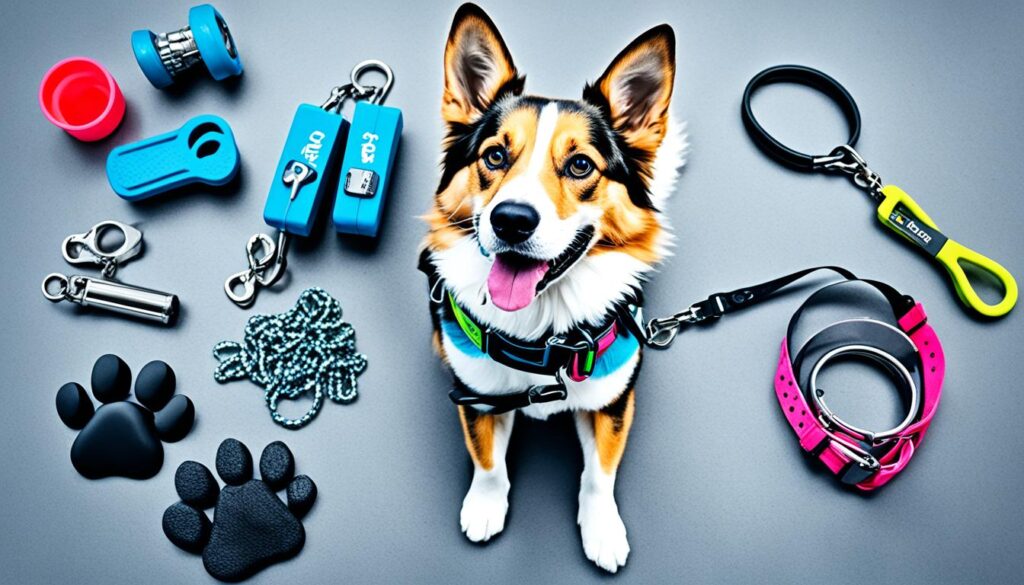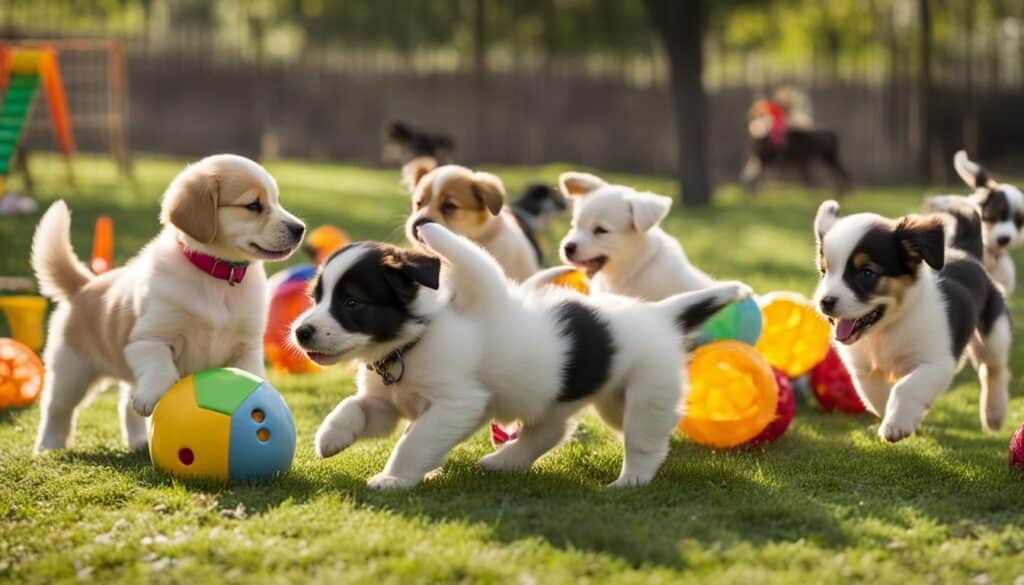Welcome to the world of dog training without the use of treats! If you’re tired of relying on treats as the sole motivator for your furry friend, you’ve come to the right place. In this article, we’ll explore the methods to effectively phasing out treats in your dog’s training regimen, allowing you to transition to without the use of treats approach that fosters a deeper connection and understanding between you and your canine companion.
While treats can be an effective tool for initial training and behavior reinforcement, it’s essential to diversify the rewards to maintain engagement and prevent dependence on food incentives. We’ll delve into why phasing out treats is crucial and the benefits of transitioning to without the use of treat training, as well as provide practical strategies to make this shift successful.

Key Takeaways:
- Phasing out treats in dog training offers numerous benefits, including enhanced engagement and motivation for your dog.
- Diversifying rewards, such as incorporating life rewards and interactive play, is essential to maintaining your dog’s enthusiasm during training sessions.
- Understanding the concept of ‘slot machine’ reward systems helps prevent treatment dependency and keeps your dog’s focus sharp.
- Transitioning from food-dependent to food-optional training empowers your dog to perform desired behaviors without food incentives.
- Practical strategies to phase out treats involve gradually reducing usage while utilizing positive reinforcement techniques.
Why Phase Out Treats in Dog Training?
When it comes to dog training, treats have long been the go-to reward. However, several important reasons exist for phasing out treats and adopting alternative reward systems. By diversifying rewards and transitioning from food-dependent to food-optional training, dog owners can tap into a more holistic approach that enhances their dog’s learning experience.
The Importance of Diversifying Rewards in Training
While treats can effectively motivate dogs during training sessions, relying solely on food rewards can limit a dog’s ability to generalize behaviors and respond to different rewards. By diversifying rewards, such as incorporating praise, play, and access to desired activities, dog owners can create a more well-rounded training program. This keeps training sessions engaging and enjoyable for dogs and prepares them to respond to various forms of reinforcement in different environments.
Understanding the Concept of ‘Slot Machine’ Reward Systems
One of the drawbacks of using treats in dog training is the potential for dogs to become dependent on them. This can lead to decreased motivation and engagement when treats are not readily available. An alternative approach is the ‘slot machine’ reward system, where rewards are given sporadically rather than every time a behavior is performed. This helps prevent dogs from relying solely on treats and maintains a high level of engagement, much like the anticipation of winning a jackpot on a slot machine.
Transitioning From Food-Dependent to Food-Optional Training
Food-dependent training refers to relying on treats as the primary source of motivation and reinforcement. While this can be effective in the initial stages of training, it is essential to transition to food-optional training as the dog progresses. Food-optional training allows dogs to perform behaviors without needing a food reward, promoting independence and ensuring they are motivated by intrinsic factors rather than external rewards.

Practical Strategies to Stop Using Treats During Training
In dog training, treats are used as a primary form of positive reinforcement. However, relying solely on treats for training can create a dependence on food rewards and limit the effectiveness of training methods. To overcome this challenge, exploring alternative strategies that can gradually reduce the use of treats while maintaining motivation and achieving desired behavior outcomes is essential.
Introducing Life Rewards: Beyond the Food Treat
Introducing life rewards as alternatives is one effective strategy to reduce dependence on treats. Life rewards are rewards derived from the dog’s environment, such as playtime, toy access, or attention from the owner. By incorporating these rewards into training sessions, you can shift the focus away from treats while providing meaningful positive reinforcement. Dogs often find life rewards highly motivating and enjoyable, making them an excellent substitute for food treats.
How to Use Tug and Play as Alternatives to Treats
Another effective strategy is to incorporate tug and play as an alternative to treats during training. Tug-of-war games, fetch sessions, or interactive play sessions can be used as rewards for desired behaviors. These activities tap into a dog’s instincts and can serve as enriching experiences. Incorporating play into your training sessions can help maintain engagement, stimulate focus, and reinforce positive behaviors without relying on food treats.
Training Your Dog with the Power of Positive Reinforcement Without Food
Positive reinforcement is a powerful training technique that can be utilized without food rewards. Verbal praise, petting, and enthusiastic encouragement can be just as motivating for dogs as food treats. By providing immediate and sincere praise when your dog exhibits desired behaviors, you can reinforce those behaviors and strengthen the bond between you and your canine companion. The key is making positive reinforcement timely, meaningful, and consistent to communicate desired expectations to your dog effectively.
When implementing these strategies, it is essential to remember that every dog is unique, and what works for one may not work for another. Observing and understanding your dog’s preferences and adapting your training methods is essential. By gradually reducing dependence on treats and incorporating alternative strategies for positive reinforcement, you can create a well-rounded training program that promotes obedience, engagement, and a strong bond between you and your dog.

How to Use Treats Appropriately in Dog Training
In dog training, treats can be valuable for reinforcing desirable behaviors and motivating your furry friend. However, it is essential to use treats appropriately to ensure adequate training outcomes. Here are some guidelines for incorporating treats into your training sessions:
Teaching Your Dog the Value of Different Types of Rewards
Teaching your dog the value of different rewards beyond just treats is essential. While treats can be highly motivating, it is beneficial to introduce a variety of rewards such as praise, petting, playtime, or access to toys. This helps prevent over-reliance on treats and ensures your dog is motivated by various rewards.
Using Treats Strategically for Training and Behavior Modification
Strategic use of treats can be a powerful training tool. Rather than providing treats for every action, use treats to reinforce specific behaviors or milestones. For example, reward your dog when they successfully perform a new trick or exhibits excellent obedience. This helps to reinforce the desired behaviors and strengthens the training bond between you and your dog.
Knowing When and How Often to Reward Your Dog
Understanding when and how often to reward your dog is critical to practical training. In the initial stages of teaching a new behavior, it is crucial to reward your dog consistently to reinforce the desired action. As your dog becomes more proficient, gradually reduce the frequency of treat rewards and transition to intermittent reinforcement. This imitates a ‘slot machine’ reward system, keeping your dog engaged and motivated to perform behaviors without expecting a treat every time.
| When to Reward Your Dog | How Often to Reward Your Dog |
| When your dog successfully completes a new behavior or trick | Consistently in the initial stages, then gradually transition to intermittent reinforcement |
| When your dog exhibits exceptional obedience or good behavior | Focus on reinforcing specific milestones rather than every action |
| During training sessions to motivate and encourage your dog | Gradually reduce the frequency of treat rewards to foster independence |
Using treats appropriately in dog training can effectively reinforce desired behaviors while preventing overdependence on treats. Remember to introduce a variety of rewards, use treats strategically, and transition to intermittent reinforcement to ensure successful training outcomes.
Phasing Out Food: Transitioning to Advanced Training Techniques
Integrating Cue-Based Training Without the Need for Treats
In the journey towards without the use of treats training, transitioning to advanced training techniques is essential. One practical approach is integrating cue-based training, which teaches dogs to respond to verbal or visual cues without needing treats.
Cue-based training involves associating specific cues or commands with desired behaviors. Instead of relying on treats as immediate rewards, dogs learn to perform behaviors in response to cues alone. This helps to build their understanding and responsiveness to commands, enhancing their overall training proficiency.
To introduce cue-based training:
- Start by reinforcing behaviors with treats as usual.
- Gradually, begin incorporating the associated cues every time you give the treat.
- Over time, the frequency of treats should be reduced while consistently using the cues.
By transitioning to cue-based training without needing treats, you cultivate a stronger connection between cues and behaviors in your dog’s training repertoire. This shift promotes better communication and allows for more precise control over your dog’s actions.
Challenges in Phasing Out Treats and How to Overcome Them
Phasing out treats during training can be challenging, as dogs may initially resist performing behaviors without food rewards. However, with patience and strategic planning, these challenges can be overcome.
One common challenge is the dog’s reliance on treats as the primary motivator. To overcome this, gradually reduce the size and value of the treats used, shifting the focus towards other forms of reward. Incorporating life rewards such as playtime, toy access, or praise can help maintain motivation and engagement during training sessions.
Another challenge is breaking the association between treats and behaviors. To address this, use variable reinforcement, where treats are given intermittently instead of every time. This creates an element of surprise and prevents predictability, making the training more engaging and reducing reliance on treats.
Consistency and persistence are essential in overcoming these challenges. Maintain a structured training schedule, set clear expectations, and reinforce behaviors consistently with non-food rewards. With time and consistency, your dog will learn to perform behaviors without relying on treats.
How Professional Dog Trainers Successfully Fade Out Food Rewards
Professional dog trainers have mastered the art of phasing out food rewards, paving the way for advanced training techniques. Their expertise offers valuable insights into successful strategies for effectively reducing treatment dependency.
One approach used by professional trainers is systematically fading out food rewards. This involves gradually decreasing the frequency and value of treats while increasing the emphasis on alternative rewards. By tapering progressively off treats, dogs learn to generalize behaviors and respond to various rewards, including praise, physical affection, and access to desired activities.
Another tactic professional trainers employ is incorporating variable rewards, as mentioned earlier. This ensures that dogs remain engaged and motivated, even without guaranteeing a treat after every behavior. It creates a sense of anticipation and curiosity, making the training more mentally stimulating.
Moreover, professional trainers focus on building a strong foundation of positive reinforcement techniques. They establish a solid relationship based on trust, consistency, and clear communication. This foundation allows for effective training outcomes, even without using food rewards.
By learning from the experiences of professional trainers, dog owners can gain valuable insights and apply successful techniques in their training practices. Their expertise demonstrates that it is possible to transition to advanced training techniques without relying on treats as the sole motivator.
Common Mistakes to Avoid When Reducing Dependency on Treats
When transitioning to without the use of treats dog training, you must be aware of common mistakes hindering progress and undermining your training efforts. By avoiding these missteps, you can ensure a smooth and successful transition that maintains your dog’s motivation and enthusiasm.
Why Suddenly Stopping Giving Treats Can Backfire
One common mistake dog owners make is abruptly stopping using treats during training. While the ultimate goal is to reduce dependence on treats, a sudden stop can backfire and decrease your dog’s motivation and enthusiasm. Dogs have come to expect rewards for their efforts, and removing treats with a proper transition plan can make them clear and motivated.
To avoid this mistake, it’s crucial to gradually phase out treats, replacing them with other types of rewards. This allows your dog to adapt to the change and continue to feel motivated to perform desired behaviors.
Maintaining Your Dog’s Motivation and Enthusiasm without Treats
Another mistake to avoid is assuming that eliminating treats means relying solely on verbal praise or physical affection as rewards. While these forms of reinforcement are valuable, more than they may be needed to maintain your dog’s motivation and enthusiasm during training sessions.
Instead, focus on diversifying rewards and incorporating different types of reinforcements, such as playtime, access to toys, or opportunities for exploration. By offering a variety of rewards that align with your dog’s preferences, you can ensure continued engagement and enthusiasm without relying on treats.
Ensuring Consistency in Training Approaches Across All Family Members
Consistency is vital in dog training, especially when transitioning away from treats. One mistake to avoid is inconsistent training approaches across different family members. If one person continues to use treats while others have stopped, it can create confusion for your dog and undermine the progress you’ve made.
To maintain consistency, it’s essential to communicate and establish a unified training plan with all family members involved in your dog’s training. This ensures that everyone follows the same guidelines and reinforcement strategies, reducing confusion or mixed signals for your dog.
| Mistake | Consequence | Alternative Approach |
| Suddenly stopping treat rewards | Backfires and reduces motivation | Gradually phase out treats and replace with other rewards |
| Relying solely on verbal praise or physical affection | Insufficient motivation and enthusiasm | Diversify rewards with playtime, toys, and exploration opportunities |
| Inconsistent training approaches among family members | Confusion and mixed signals for the dog | Establish a unified training plan and communicate with all family members |
Making the Shift: Practical Tips to Start Phasing Out Treats
When transitioning to without the use of treats dog training, setting realistic goals for you and your furry companion is crucial. Understand that phasing out treats is a process that takes time and patience. Start by identifying the behaviors and commands your dog has already mastered and focus on reinforcing those without treats. By building on the foundation of their existing training, you can shift their reliance from treats to other rewards.
Setting Realistic Goals for You and Your Dog in the Journey Towards without the use of treats Training
In your journey towards removing the use of treats in training, it is essential to establish attainable goals. Begin by selecting one behavior at a time that you would like your dog to perform reliably without treats. Break down the desired behavior into smaller steps and gradually reduce the use of treats as your dog becomes proficient. Celebrate milestones and acknowledge progress, both for your dog and yourself. You and your four-legged friend can achieve phasing out treats successfully with consistent effort and positive reinforcement.
Adapting Your Training Sessions for Long-Term Success Without Treats
To sustain long-term success without treats, it is essential to adapt your training sessions. Incorporate a variety of rewards, such as praise, petting, or playtime, to keep your dog engaged and motivated. Vary the intensity and frequency of rewards to maintain their interest. Integrate interactive toys, games, and mental stimulation exercises into your training routine to provide alternative sources of reinforcement.
Conclusion
Gradually reducing treat usage while keeping your dog engaged and focused requires a strategic approach. Begin by decreasing the size and value of treats used during training sessions. Introduce intermittent reinforcement, providing treats occasionally instead of every time your dog performs a desired behavior. Offer praise, petting, or a brief play session as immediate rewards, gradually reducing their reliance on food treats. Additionally, verbal cues, hand signals, or environmental rewards can be substitutes for treats to reinforce desired behaviors. Through gradual progression, your dog will learn to perform without treats while maintaining a high level of engagement.

